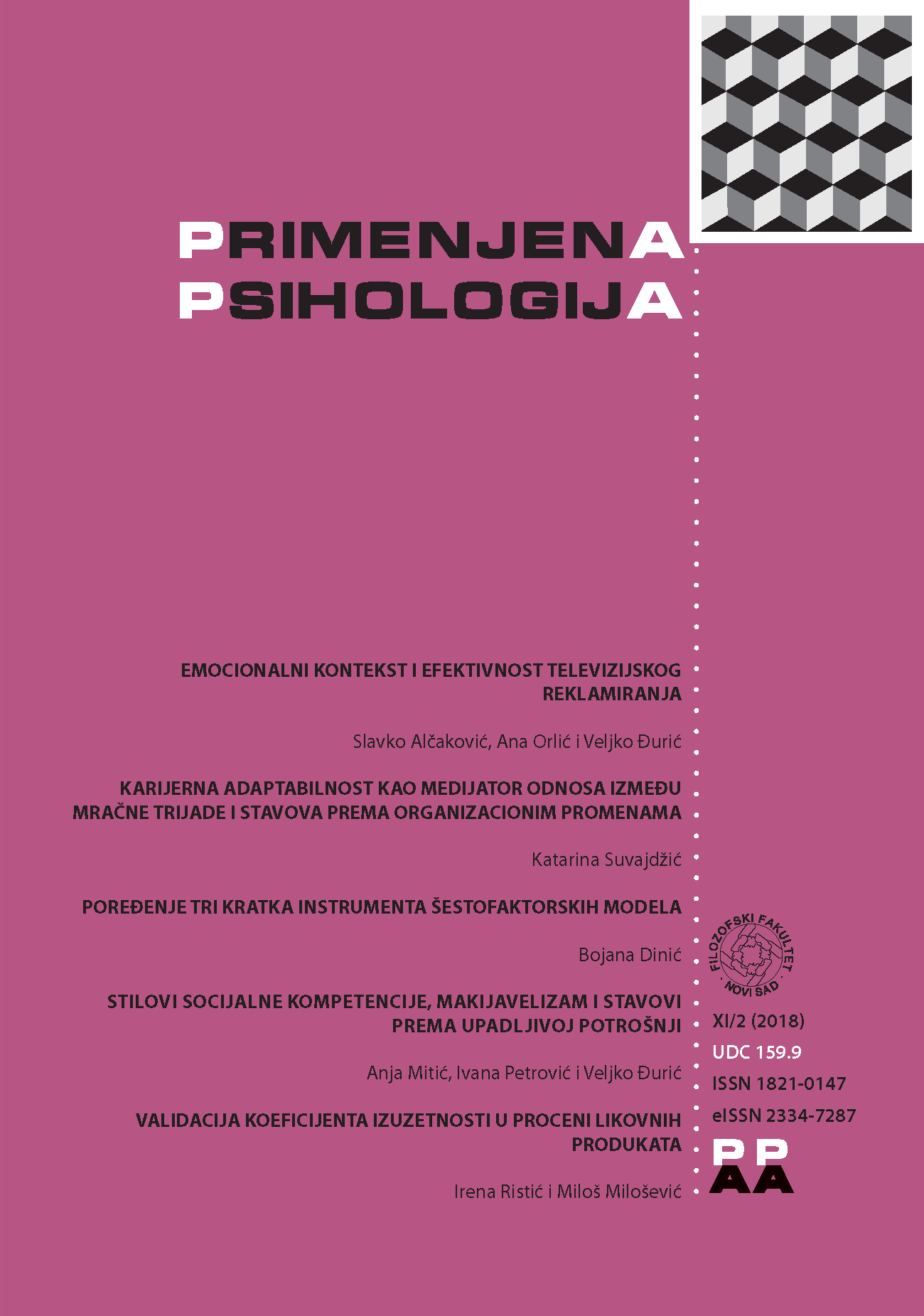COMPARISON OF THREE SHORT SIX-FACTOR PERSONALITY INSTRUMENTS
DOI:
https://doi.org/10.19090/pp.2018.2.189-206Keywords:
short inventory, HEXACO, 24QB6, Mini-IPIP6, BHIAbstract
The aim of this research was to validate Serbian adaptations of three short six-factor model measures: 24 Questionnaire Big Six (24QB6), Mini-IPIP6, and Brief HEXACO Inventory (BHI). Besides these measures, HEXACO-100 was applied on a sample of 310 participants (41% of male) from the general population. The results of confirmatory factor analysis showed marginal fit indices for 24QB6, and satisfactory fit indices for Mini-IPIP6, but not for BHI. BHI also had the smallest Cronbach’s alphas for the scales, but the highest correlations with matching HEXACO-100 scales, confirming its convergent and discriminant validity. Regarding 24QB6, it was noticeable that all scales were valid, except for Honesty/Propriety, which showed substantial relations with both Honesty-Humility and Conscientiousness. Scales from Mini-IPIP6 had the highest alphas, but also the highest mean inter-item correlation, indicating that they measured a narrower scope of the traits. Also, validity of the Agreeableness scale was limited. Taken together, all the measures had advantages and disadvantages, and authors should choose a short measure in line with the importance of either validity or reliability.
References
Ashton, M. C., & Lee, K. (2009). The HEXACO-60: A short measure of the major dimensions of personality. Journal of Personality Assessment, 91, 340–345. doi:10.1080/00223890902935878
Ashton, M. C., Lee, K., & de Vries, R. E. (2014). The HEXACO Honesty-Humility, Agreeableness, and Emotionality factors: A review of research and theory. Personality and Social Psychology Review, 18, 139–152. doi:10.1177/1088868314523838
Campbell, W. K., Bonacci, J. K., Shelton, J., Exline, J. J., & Bushman, B. J. (2004). Psychological entitlement: Interpersonal consequences and validation of a selfreport measure. Journal of Personality Assessment, 83, 29–45. doi:10.1207/ s15327752jpa8301_04
Clark, A. D., & Watson, D. (1995). Construct validity: Basic issues in objective scale development. Psychological Assessment, 7, 309–319.
De Vries, R. E. (2013). The 24-item Brief HEXACO Inventory (BHI). Journal of Research in Personality, 47, 871–880. doi:10.1016/j.jrp.2013.09.003
De Vries, R. E., & Born, M. P. (2013). De vereenvoudigde HEXACO persoonlijkheidsvragenlijst en eenadditioneelinterstitieelproactiviteitsfacet [The simplified HEXACO personality inventory and an additional interstitial proactivity facet]. Gedrag and Organisatie, 26, 222–243.
Donnellan, M. B., Frederick, L., Oswald, B. M. B, & Lucas, R. E. (2006). The Mini IPIP scales: Tiny-yet-effective measures of the Big Five factors of personality. Psychological Assessment, 18, 192–203. doi:10.1037/1040-3590.18.2.192
Glorfeld, L. W. (1995). An improvement on Horn’s parallel analysis methodology for selecting the correct number of factors to retain. Educational and Psychological Measurement, 55(3), 377–393. doi:10.1177/0013164495055003002 Goldberg, L. R. (1992). The development of markers for the Big-Five factor structure. Psychological Assessment, 4, 26–42. doi:10.1037/1040-3590.4.1.26 Goldberg, L. R. (1999). A broad-bandwith, public-domain, personality inventory measuring the lower-level facets of several Five-Factor models. In I. Mervielde, I. J. Deary, F. de Fruyt, & F. Ostendorf (Eds.), Personality psychology in Europe (Vol. 7, pp. 7–28). Tilburg: Tilburg University Press.
Hu, L., & Bentler, P. M. (1999). Cutoff criteria for fit indexes in covariance structure analysis: Conventional criteria versus new alternatives. Structural Equation Modeling, 6, 1–55. doi:10.1080/10705519909540118
Lee, K., & Ashton, M. C. (2008). The HEXACO personality factors in the indigenous personality lexicons of English and 11 other languages. Journal of Personality, 76, 1002–1054. doi:10.1111/j.1467–6494.2008.00512.x
Lee, K., & Ashton, M. C. (in press). Psychometric properties of the HEXACO-100. Assessment. doi:10.1177/1073191116659134
Međedović, J. (2014). Should the space of basic personality traits be extended to include the disposition toward psychotic-like experiences? Psihologija, 47, 169–184. doi:10.2298/PSI1402169M
Međedović, J., & Bulut, T. (2017). The Mini IPIP-6: Short, valid, and reliable measure of the Six-factor personality structure. Primenjena psihologija, 10, 185– 202. doi:10.19090/pp.2017.2.185-202
Međedović, J., Čolović, P., Dinić, B., & Smederevac, S. (2017, in press). The HEXACO Personality Inventory: Validation and psychometric properties in the Serbian language. Journal of Personality Assessment. doi:10.1080/00223891.2017.13 70426
Milojev, P., Osborne, D., & Sibley, C. G. (2014). Personality resilience following a natural disaster. Social Psychological and Personality Science, 5, 760–768. doi:10.1177/1948550614528545
Milojev, P., Osborne, D., Greaves, L. M., Barlow, F. K., & Sibley, C. G. (2013). The Mini-IPIP6: Tiny yet highly stable markers of Big Six personality. Journal of Research in Personality, 47, 936–944. doi:10.1016/j.jrp.2013.09.004
O’Connor, B. P. (2000). SPSS and SAS programs for determining the number of components using parallel analysis and Velicer’s MAP test. Behavior Research Methods, Instrumentation, and Computers, 32(3), 396–402. doi:10.3758/ BF03200807
Oostrom, J. K., Köbis, N. C., Ronay, R., &Cremers, M. (2017). False consensus in situational judgment tests: What would others do? Journal of Research in Personality, 71, 33-45. doi:10.1016/j.jrp.2017.09.001
Rosseel, Y. (2012). lavaan: An R package for structural equation modeling. Journal of Statistical Software, 48, 1–36. doi:10.18637/jss.v048.i02
Saucier, G. (2009). Recurrent personality dimensions in inclusive lexical studies: Indications for a Big Six structure. Journal of Personality, 77, 1577–1614. doi:10.1111/j.1467-6494.2009.00593.x
Sibley, C. G. (2012). The Mini-IPIP6: Item Response Theory analysis of a short measure of the big-six factors of personality in New Zealand. New Zealand Journal of Psychology, 41, 21–31.
Sibley, C. G., Luyten, N., Purnomo, M., Moberly, A., Wootton, L. W., Hammond, M. D., & Robertson, A. (2011). The Mini-IPIP6: Validation and extension of a short measure of the Big Six factors of personality in New Zealand. New Zealand Journal of Psychology, 40, 142–159.
Stankov, L., Saucier, G., & Knežević, G. (2010). Militant extremist mind-set: Proviolence, vile world, and divine power. Psychological Assessment, 22, 70–86. doi:10.1037/a0016925
Thalmayer, A. G., & Saucier, G. (2014). The Questionnaire Big Six in 26 nations: Developing cross-culturally applicable Big Six, Big Five and Big Two inventories. European Journal of Personality, 28, 482–496. doi:10.1002/per.1969
Thalmayer, A. G., Saucier, G., & Eigenhuis, A. (2011). Comparative validity of brief to medium-length Big Five and Big Six Personality Questionnaires. Psychological Assessment, 23(4), 995–1009. doi:10.1037/a0024165
Thielmann, I., Hilbig, B. E., Zettler, I., & Moshagen, M. (2017). On measuring the six basic personality dimension: A comparison between HEXACO Honesty-Humility and Big Six Honesty-Propriety. Assessment, 24, 1024–1036. doi:10.1177/1073191116638
Timmerman, M. E., & Lorenzo-Seva, U. (2011). Dimensionality assessment of ordered polytomous items with parallel analysis. Psychological Methods, 16(2), 209–220. doi:10.1037/a0023353







